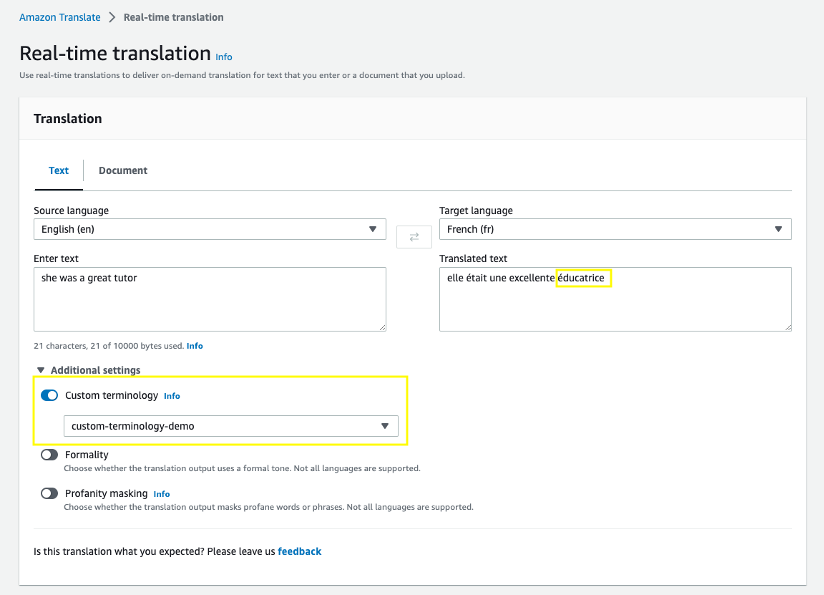Amazon Translate is a neural machine translation service that delivers fast, high-quality, affordable, and customizable language translation. When you translate from one language to another, you want your machine translation to be accurate, fluent, and most importantly contextual. Domain-specific and language-specific customizable terminology is a key requirement for many government and commercial organizations.
Custom terminology enables you to customize your translation output such that your domain and organization-specific vocabulary, such as brand names, character names, model names, and other unique content (named entities), are translated exactly the way you need. To use the custom terminology feature, you should create a terminology file (CSV or TMX file format) and specify the custom terminology as a parameter in an Amazon Translate real-time translation or asynchronous batch processing request. Refer to Customize Amazon Translate output to meet your domain and organization specific vocabulary to get started on custom terminology.
In this post, we explore key enhancements to custom terminology, which doesn’t just do a simple match and replace but adds context-sensitive match and replace, which preserves the sentence construct. This enhancement aims to create contextually appropriate versions of matching target terms to generate translations of higher quality and fluency.
Solution overview
We use the following custom terminology file to explore the enhanced custom terminology features. For instructions on creating a custom terminology, refer to Customize Amazon Translate output to meet your domain and organization specific vocabulary.
| en | fr | es |
| tutor | éducateur | tutor |
| sheep | agneau | oveja |
| walking | promenant | para caminar |
| burger | sandwich | hamburguesa |
| action-specific | spécifique à l’action | especifico de acción |
| order | commande | commande |
Exploring the custom terminology feature
Let’s translate the sentence “she was a great tutor” with Amazon Translate. Complete the following steps:
- On Amazon Translate console, choose Real-time translation in the navigation pane.
- Choose the Text tab.
- For Target language, choose French.
- Enter the text “she was a great tutor.”
As shown in the following screenshot, the translation in French as “elle était une excellente tutrice.”

- Under Additional settings¸ select Custom terminology and choose your custom terminology file.
The translation in French is changed to “elle était une excellente éducatrice.”

In the custom terminology file, we have specified the translation for “tutor” as “éducateur.” “Éducateur” is masculine in French, whereas “tutor” in English is gender neutral. Custom terminology did not perform a match and replace here, instead it used the target word and applied the correct gender based on the context.
Now let’s test the feature with the source sentence “he has 10 sheep.” The translation in French is “il a 10 agneaux.” We provided custom terminology for “sheep” as “agneau.” “Agneau” in French means “baby sheep” and is singular. In this case, the target word is changed to inflect plural.
The source sentence “walking in the evening is precious to me” is translated to “me promener le soir est précieux pour moi.” The custom terminology target word “promenant” is changed to “promener” to inflect the correct verb tense.
The source sentence “I like burger” will be translated to “J’aime les sandwichs” to inflect the correct noun based on the context.
Now let’s test sentences with the target language as Spanish.
The source sentence “any action-specific parameters are listed in the topic for that action” is translated to “odos los parámetros especificos de acción aparecen en el tema de esa acción” to inflect the correct adjective.
The source sentence “in order for us to help you, please share your name” will be translated to “pour que nous puissions vous aider, veuillez partager votre nom.”
Some words may have entirely different meanings based on context. For example, the word “order” in English can be a sequence (as is in the source sentence) or a command or instruction (as in “I order books”). It’s difficult to know which meaning is intended without explicit information. In this case, “order” should not be translated as “commande” because it means “command” or “instruct” in French.
Conclusion
The custom terminology feature in Amazon Translate can help you customize translations based on your domain or language constructs. Recent enhancements to the custom terminology feature create contextually appropriate versions of matching terms to generate translations of higher quality. This enhancement improves the translation accuracy and fluency. There is no change required for existing customers to use the enhanced feature.
For more information about Amazon Translate, visit Amazon Translate resources to find video resources and blog posts, and refer to AWS Translate FAQs.
About the Authors
 Sathya Balakrishnan is a Senior Consultant in the Professional Services team at AWS, specializing in data and ML solutions. He works with US federal financial clients. He is passionate about building pragmatic solutions to solve customers’ business problems. In his spare time, he enjoys watching movies and hiking with his family.
Sathya Balakrishnan is a Senior Consultant in the Professional Services team at AWS, specializing in data and ML solutions. He works with US federal financial clients. He is passionate about building pragmatic solutions to solve customers’ business problems. In his spare time, he enjoys watching movies and hiking with his family.
 Sid Padgaonkar is the Senior Product Manager for Amazon Translate, AWS’s natural language processing service. On weekends, you will find him playing squash and exploring the food scene in the Pacific Northwest.
Sid Padgaonkar is the Senior Product Manager for Amazon Translate, AWS’s natural language processing service. On weekends, you will find him playing squash and exploring the food scene in the Pacific Northwest.
- SEO Powered Content & PR Distribution. Get Amplified Today.
- PlatoData.Network Vertical Generative Ai. Empower Yourself. Access Here.
- PlatoAiStream. Web3 Intelligence. Knowledge Amplified. Access Here.
- PlatoESG. Automotive / EVs, Carbon, CleanTech, Energy, Environment, Solar, Waste Management. Access Here.
- PlatoHealth. Biotech and Clinical Trials Intelligence. Access Here.
- ChartPrime. Elevate your Trading Game with ChartPrime. Access Here.
- BlockOffsets. Modernizing Environmental Offset Ownership. Access Here.
- Source: https://aws.amazon.com/blogs/machine-learning/amazon-translate-enhances-its-custom-terminology-to-improve-translation-accuracy-and-fluency/



